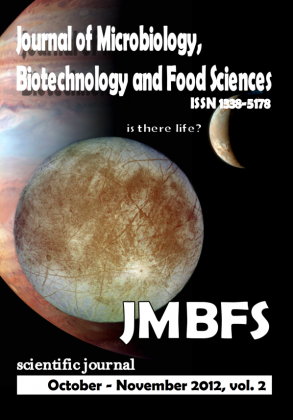EFFECT OF ELECTROMAGNETIC FIELD ON THE SPOILAGE FUNGI OF SOME SELECTED EDIBLE FRUITS IN SOUTHWESTERN, NIGERIA
Keywords:
Berry, electromagnetic field, spoilage, fungi, controlAbstract
The influence of electromagnetic field wave on the survival of spoilage fungi associated with some edible fruits consumed in southwestern, Nigeria was studied using cashew (Anacardium occidentale L.), pineapple (Ananas comosus), carrot (Daucus carota), cucumber (Cucumis sativus), apple (Malus domestica) and African star apple (Chrysophyllum africanum). The spoilage fungi used include the genera of Aspergillus, Penicillium, Articulospora, Mucor, Staphylotrichum, Bisbyopeltis, Fusarium, Rhizopus and a yeast, Saccharomyces cerevisiae. There was a general decrease in fungal growth as shown in the number of spores produced with increase in exposure time of isolates to electromagnetic field except in Articulospora inflata, Penicillium italicum and Mucor mucedo where there was stimulatory effect as there was increase in the fungal spores compared to the control. A decrease was also observed in growth of the fungal isolates with increase in the intensity of the electromagnetic field at voltage of 7 V to 10 V and from 10 V to 13 V. The highest percentage reduction was recorded by Bisbyopeltis phoebesii at intensity of voltage 13V after 60 minutes of exposure. Exposure of the fruits to electromagnetic field wave did not alter the nutrient components of the fruits as observed in the proximate and mineral contents of the treated and untreated fruits. The result of the study revealed that electromagnetic field wave has great potential for use in the control of fruits spoilage and food preservation.Downloads
Download data is not yet available.
Downloads
Published
2012-10-01
How to Cite
J. Akinyele, B., C. Akinkunmi, O., & D. Adedayo, K. (2012). EFFECT OF ELECTROMAGNETIC FIELD ON THE SPOILAGE FUNGI OF SOME SELECTED EDIBLE FRUITS IN SOUTHWESTERN, NIGERIA. Journal of Microbiology, Biotechnology and Food Sciences, 2(2), 701–712. Retrieved from https://office2.jmbfs.org/index.php/JMBFS/article/view/7175
Issue
Section
Microbiology
License
Copyright (c) 2012 Bamidele J. Akinyele, O. C. Akinkunmi, K. D. Adedayo

This work is licensed under a Creative Commons Attribution 4.0 International License.
All papers published in the Journal of Microbiology, Biotechnology and Food Sciences are published under a CC-BY licence (CC-BY 4.0). Published materials can be shared (copy and redistribute the material in any medium or format) and adapted (remix, transform, and build upon the material for any purpose, even commercially) with specifying the author(s).

